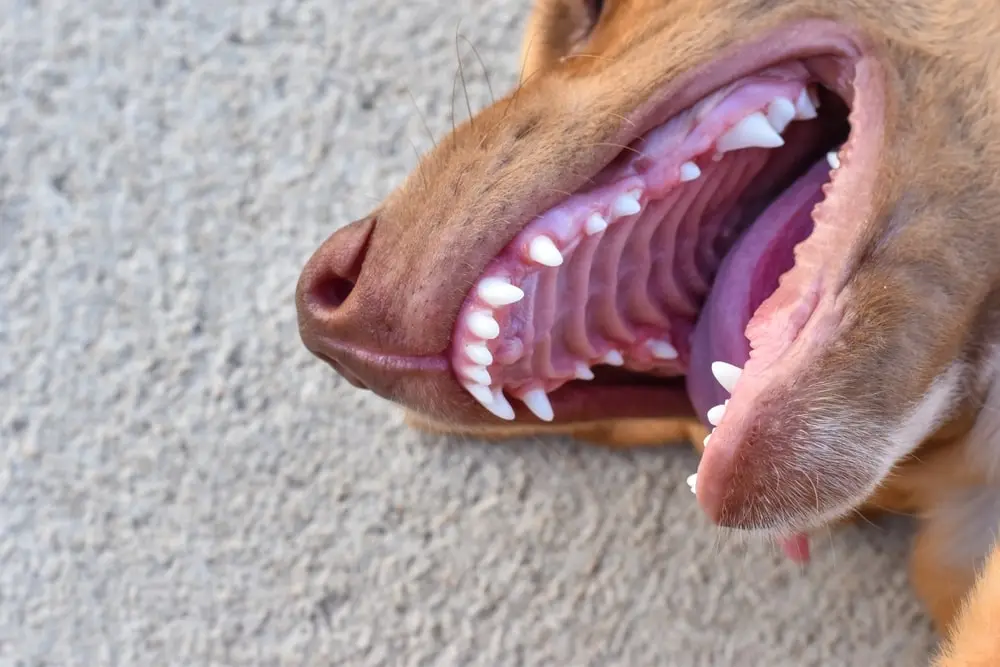Whether it’s sniffing, licking, or chewing, dogs tend to take a mouth-first approach to the world. Unfortunately, this can make them prone to oral infections, which can lead to conditions like oral papillomas. Identifiable as a wart on or in your dog’s mouth, canine oral papillomas are not always a cause for concern – but they should be given prompt attention. Keep reading to learn where these warts come from and how to deal with them safely.
What Causes Dog Mouth Warts?
Oral papillomas are a common form of benign tumor.1 They are caused by infectious papillomaviruses and typically affect the lining of a dog’s mouth, throat, or esophagus. Because these viruses are species specific, they usually spread via contact with other dogs.
Humans cannot be infected by a canine-specific virus. The one exception is the sheep-pox virus. Dogs exposed to this virus can develop wart-like masses and may infect other species, including humans, through direct contact.1
How common is the oral papilloma virus in dogs?
Dog mouth warts are fairly common in puppies and younger dogs. This can be chalked up to a lack of immunity combined with an environment that promotes viral transmission. For example, outbreaks have been observed in doggy daycare shelters.2 Fortunately, this is not a life-threatening disease!
A MetLife Pet Policy May Help Cover Wart Removal Costs
What Are the Symptoms of Papillomas in Dogs?
You can identify canine oral papillomas by their cauliflower-like appearance.1 They typically occur as swellings on a dog’s gums or mouth lining and can sometimes bleed. Papillomas can also form in the throat or esophagus. If you notice your dog having trouble swallowing their food, it could be an indicator of papillomas.1
Are Dog Mouth Warts Dangerous?
Oral papillomas are considered benign tumors. That means that, although they can be unsightly and uncomfortable for your dog, they are not likely to cause the type of health problems one imagines when hearing “cancer.”1 However, it’s still important to have canine oral papillomas examined and diagnosed by your trusted vet. They can rule out other, more dangerous types of tumors, and provide steps for treatment.
How Are Papillomas in Dogs Diagnosed?
Because oral papillomas have a characteristic location and cauliflower-like shape, they can often be diagnosed on sight alone. However, your vet may recommend further testing for a more conclusive diagnosis. This may involve:
- X-rays to ensure the warts are not caused by bone cancer in the jaw
- Biopsy, or removal of a tissue sample, to rule out other malignant cancers
Your vet might do this testing, or it may need to be handled by a veterinary pathologists at a specialty clinic.2 This may impact the overall cost of care, which can range from several hundred to several thousand dollars.3 A dog insurance policy could help cover the cost of both diagnosis and treatment, but it’s important to purchase a plan before warts appear. Otherwise, it could be considered a pre-existing condition.
What Does Dog Oral Papilloma Treatment Involve?
The simplest and most effective way to treat oral warts on a dog is to have them removed. Sometimes oral warts can disappear on their own as your pup’s immune system fights the infection, but you may not want to wait that long. Oral papillomas can become ulcerated, which could lead to a secondary infection with even more symptoms and risks to worry about.1
On the other hand, your vet may recommend waiting at least a month after infection before having the warts removed. This gives your dog’s immune system enough time to produce the antigens that will protect them from future infection.1
In cases where surgery is not an option, your vet may recommend medication instead. Anti-inflammatory medicine could help reduce the swelling of the papillomas and reduce your dog’s overall discomfort. Other medication may be recommended to help boost your dog’s immune system.1
Dogs that have had their oral warts surgically removed will need to wear an Elizabethan collar during recovery.1 Complications such as bleeding, swelling, and difficulty eating can happen.1 Contact your vet right away if any of these side effects arise.
Pet Insurance Can Help With Dog Wart Removal Costs
Keeping your dog happy and healthy is the top priority of every dog parent, but sometimes financial barriers get in the way. MetLife Pet Insurance is here to help shoulder the burden of vet bills so you can focus on your pup’s health. In one real-life example, MetLife Pet helped the parents of a one-year-old Chihuahua in California named Kula cover the cost of surgical papilloma removal. The bill was nearly $660, but Kula’s dog insurance covered over $590 – almost 90% of the cost!4,5
Read more about what MetLife Pet Insurance does and doesn’t cover. Then, find out how much you could save by getting a free quote today.


